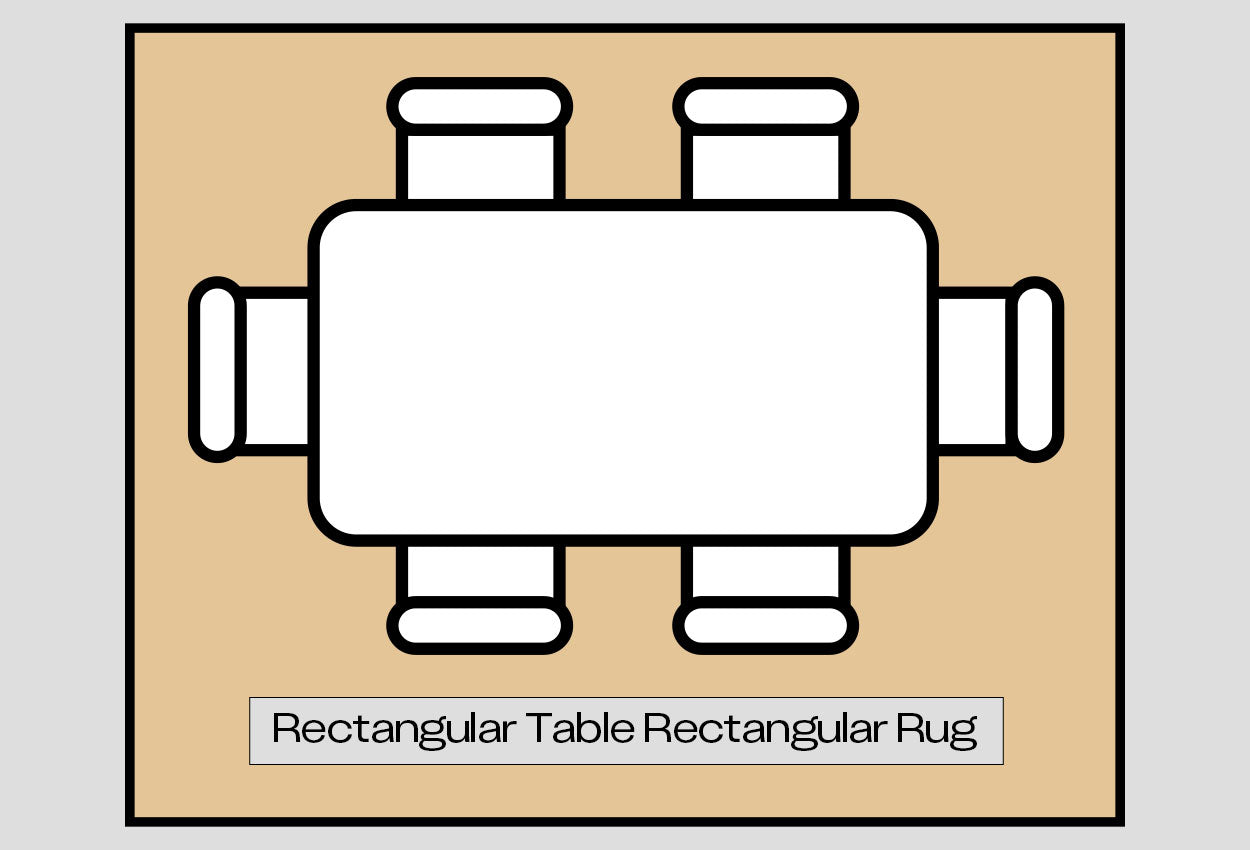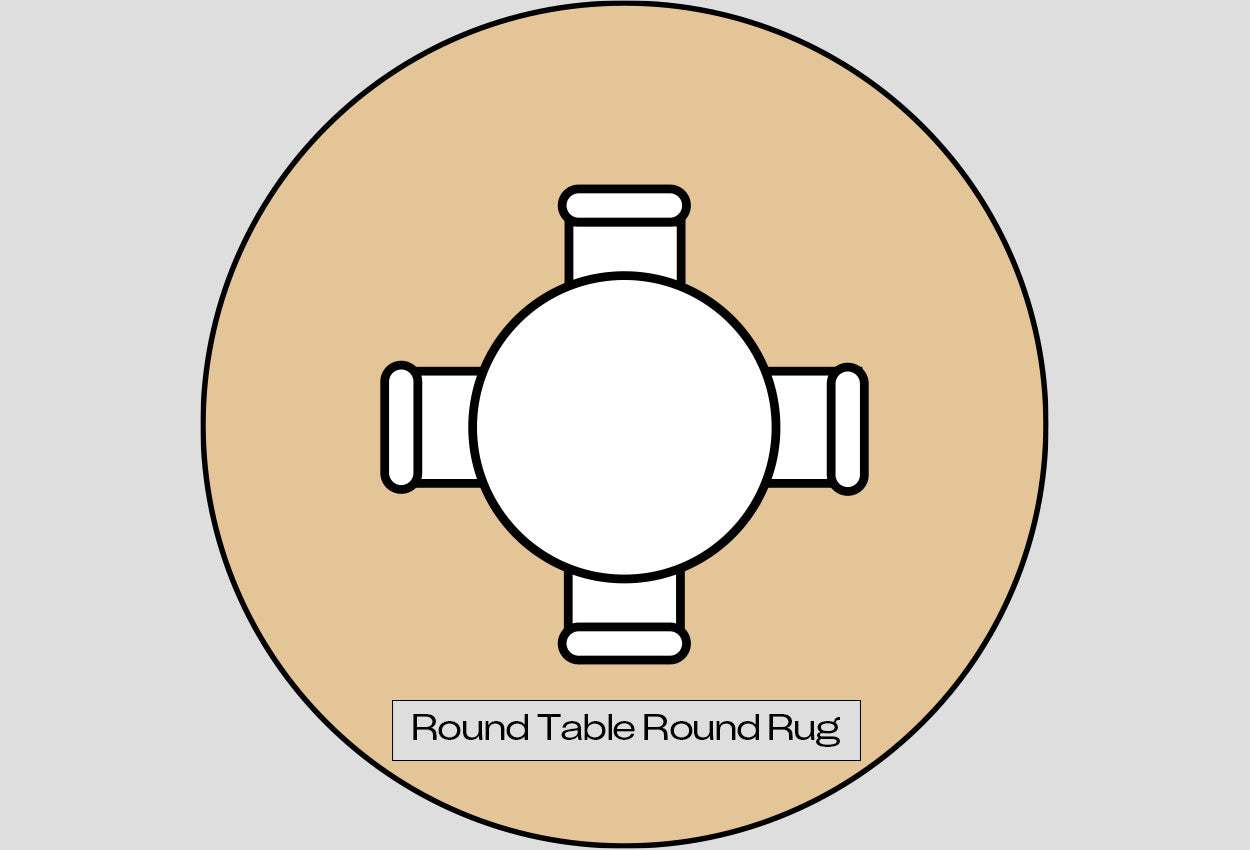The Ultimate Rug Size Guide: Choosing The Perfect Rug For Your Space
Rugs may be used to cover broadloom, tile, and wood floors. Choosing the correct size rug before shopping is essential since the wrong size might detract from the space's aesthetic. The rug's positioning also impacts how the room looks as a whole.
Due to poor size or price judgments, people often choose carpets that are too small for their room or are placed incorrectly. Use the advice in this rug size guide to choose the right area rug for your space.
Rug Sizes
Rugs come in various standard sizes that cater to different room dimensions and purposes. These sizes can generally be small, medium, and large.
Small Rugs

Small rugs typically measure around 2' x 3' to 4' x 6'. They are suitable for compact areas such as entryways, small bedrooms and accent rugs in various spaces.
Medium Rugs

Medium-sized rugs range from approximately 5' x 8' to 6' x 9'. These versatile rugs work well in living rooms, dining rooms, and bedrooms.
Large Rugs

Large rugs are commonly sized from 8' x 10' to 9' x 12' or even larger. They are ideal for spacious rooms, such as living rooms, dining rooms, and open-concept areas.
Types Of Rugs
Understanding common rug size terminology will help you navigate the available options and make informed choices for your needs.
Runner Rugs

Runner rugs are long and narrow, typically around 2' x 6' to 2' x 12'. They are perfect for hallways, entryways, and narrow spaces.
Area Rugs

Area rugs refer to rugs that cover a designated area in a room. They come in various sizes and shapes, including rectangular, square, round, and oval.
Room-Size Rugs

Room-size rugs are large rugs that cover a significant portion of the entire floor area in a room. They provide a cohesive and unified look to the space.
Factors To Consider When Choosing A Rug Size
A. Room Dimensions And Layout
- Measuring the Room: Before selecting a rug size, measure your room accurately to determine the available floor space. Consider the dimensions of the room, including length, width, and any nooks or architectural features that may affect rug placement.
- Furniture Placement: Take into account the layout and placement of your furniture. Decide whether you want the furniture to rest partially or entirely on the rug or prefer a floating look.
B. Rug Placement Options
- Centred Rug Placement: Centering the rug in the room is a popular choice, especially in living rooms and bedrooms. It creates a focal point and anchors the furniture arrangement.
- Floating Rug Placement: Floating the rug, where none of the furniture touches the rug, can work well in some rooms, particularly if you have beautiful flooring you want to showcase.
- Furniture-on-Rug Placement: Placing furniture partially or wholly on the rug can help define specific areas within a room. This approach is commonly used in dining rooms and living rooms.
Choosing The Right Rug Size For Different Rooms
A. Living Room Rug Sizes
Consider the size and placement of your furniture to determine the optimal rug dimensions. Decide whether you want an accent rug that defines a specific area or a larger rug that covers most of the living room floor. Both options can work depending on your style preferences and the size of your room.
Everything On The Rug
A standard living room's standard rug size is 8' x 10' or 9' x 12'. These sizes provide ample coverage and create a cohesive look in the room.
A. Living Room Rug Sizes
Consider the size and placement of your furniture to determine the optimal rug dimensions. Decide whether you want an accent rug that defines a specific area or a larger rug that covers most of the living room floor. Both options can work depending on your style preferences and the size of your room.
Everything On The Rug
A standard living room's standard rug size is 8' x 10' or 9' x 12'. These sizes provide ample coverage and create a cohesive look in the room.

Rug Just Covers The Forelegs
A 5' x 8' rug can work well if you have a smaller living room. These sizes still provide sufficient coverage while complementing the proportions of a smaller space.

Legs Off
Although only sometimes advised, a small rug Size 6' X 9' may be an affordable option while enhancing the design and comfort of your living area. Consider a little rug that floats in the middle of your seating arrangement if you have limited space. A modest area rug will seem deliberate and well-styled as long as it is appropriately centred amid your furnishings.

B. Bedroom Rug Sizes
Fully Covered the Bed
Consider a 9' × 12' or 10' × 14' rug if your main bedroom is big enough to accommodate the bed and bedside tables when positioned perpendicular to them. An 8' x 10' foot rug can fit a king or super king-size bed and side tables in a larger space.

Rug Under The Bed
You can place a rug under the bed or use multiple rugs to define different bedroom areas. For under the bed, a common choice is an 8’ × 10’ rug that extends at least 2-3 feet beyond the sides and feet of the bed.

Rugs Beside The Bed
If you prefer rugs beside the bed, consider smaller rugs, such as 2' x 3' or 3' x 5', placed alongside each side of the bed. These rugs should extend beyond the foot of the bed and provide a soft surface for your feet when getting in and out of bed.

C. Dining Room Rug Sizes
Rectangular Rug
Measure your dining table and add approximately 4 feet to each side to determine the minimum rug size needed. This ensures that the chairs remain on the rug even when pulled out. Select a rug for a dining room that accommodates the dining table and chairs when pulled out. Ideally, an 8′ x 10′ rug should stretch at least 2 feet beyond the sides of the table to accommodate chair mobility.

Round Rug
Select a rug that matches the design of your dining table. A round dining table and rug provide lovely curves that lighten a room. The rug size rules for rectangular tables apply to round tables. Unless you have an oversized round table, an 8' x 8' round rug will probably be the best fit for your room.

D. Kitchen Rug Sizes
Kitchen Rug
Rugs define specific areas in the kitchen, such as in front of the sink or stove. Smaller rugs, like 2' x 3' or 3' x 5', are commonly used for these purposes.

Kitchen Runners
For kitchen runners, measure the length of the countertop or island and choose a runner rug that extends a few inches on either end. Typical kitchen runner sizes range from 2' x 6' to 2' x 12'.

E. Entryway And Hallway Rug Sizes
Entryways Rug
In entryways, consider the available space and the width of the door. A standard entryway rug size is around 3' x 5' or 4' x 6'. If you have a spacious entryway, you can opt for larger sizes.

Hallways Runner Rugs
For hallways, runner rugs are an excellent choice. Measure the length and width of the hallway and select a runner rug size that suits the dimensions. Standard hallway runner sizes range from 2' x 6' to 2' x 12'.

Rug Size Guide For Special Areas
Nursery Rugs
Ensure the rug in a nursery or children's room has a non-slip backing to prevent accidents. Soft and plush rugs in sizes like 4' x 6' or 5' x 8' are commonly used in these spaces.

Children's Rooms Rug
For children's rooms, consider larger rugs that provide ample floor coverage, such as 6' x 9' or 8' x 10'. This allows for comfortable play and adds a cosy atmosphere.

Rug For Offices
Choose a rug size in an office or study area that comfortably accommodates your desk and chair. A 5' x 8' or 6' x 9' rug can work well in most cases.

Study Area Rug
Consider a rug that extends beyond the desk area to create a cosy reading or sitting nook within the office or study space. Adding a 2' x 3' or 3' x 5' rug in this area can enhance comfort and style.

How to Measure For A Rug
Room Measurements

To measure for a rug, tape and record the room's dimensions, including length and width. Consider any alcoves or architectural features that may impact rug placement.
Furniture Considerations
Measure the furniture in the room and decide if you want the furniture to rest partially or wholly on the rug. This will help determine the appropriate rug size and placement options.
Tips for Accurate Rug Sizing
- Consider any borders or edges on the rug when measuring and selecting a size. These factors can affect the overall dimensions and visual impact of the rug.
- Different rug shapes, such as rectangular, square, round, or oval, can affect how they fit within a space. Consider the style of your room and choose a rug shape that complements the overall aesthetic.
Conclusion
The right rug size is crucial for creating a functional and well-designed environment. Understanding standard rug sizes, considering room dimensions and furniture placement, and exploring different options helps make informed decisions. Specific rug size recommendations are provided for living rooms, bedrooms, dining rooms, kitchens, entryways, and hallways. Accurate sizing requires measuring the room and considering rug borders, edges, and style.
Following this comprehensive guide, you can confidently choose the perfect rug size for your space, creating a stylish and harmonious atmosphere that suits your needs and preferences.
Frequently Asked Questions
What size rug should I choose for a small living room?
For a small living room, a 5' x 8' or 6' x 9' rug can work well. Consider the dimensions of your living room and furniture placement to determine the optimal size.
What is the ideal rug size for a round dining table?
For a round dining table, choose a rug that is at least 2 feet wider than the diameter of the table. This allows for chair movement and ensures a visually balanced look.




